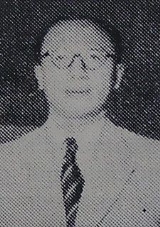
Djuanda Kartawidjaja
Encyclopedia
Raden Djuanda Kartawidjaja (14 January 1911 Tasikmalaya
, West Java
- 7 November 1963 Jakarta
) was an ethnic Sundanese
noble
from the court of Cirebon
, an Indonesian politician and the 11th and the final Prime Minister of Indonesia. Raden Djuanda Kartawidjaja, usually referred to simply as Djuanda, served as Minister of Communications in seven cabinets from 1946 to 1949 and 1950 to 1953; as Minister of State in 1949 and Minister of Welfare from 1949 to 1950. Djuanda was Indonesia's final Prime Minister in Sukarno
"Karya" cabinets, the final cabinets of the Liberal Democracy Era
(prior to the Guided Democracy period) and as First Minister from 1959 until his death in 1963.
Djuanda's death and the abolition of the post of Prime Minister in the Indonesian Republican system allowed far greater power to be exercised by the President- now being given full ruling power with minimal oversight, as both Head of State and Head of Government. This had an enormous impact on Indonesian politics, allowing the constitutional legality of the autocracy
of Sukarno
and Suharto.
Tasikmalaya
Tasikmalaya is a city in southeastern West Java, Indonesia, between Bandung and Purwokerto on the southerly of the two major road routes across Java...
, West Java
West Java
West Java , with a population of over 43 million, is the most populous and most densely populated province of Indonesia. Located on the island of Java, it is slightly smaller in area than densely populated Taiwan, but with nearly double the population...
- 7 November 1963 Jakarta
Jakarta
Jakarta is the capital and largest city of Indonesia. Officially known as the Special Capital Territory of Jakarta, it is located on the northwest coast of Java, has an area of , and a population of 9,580,000. Jakarta is the country's economic, cultural and political centre...
) was an ethnic Sundanese
Sundanese people
The Sundanese are an ethnic group native to the western part of the Indonesian island of Java. They number approximately 31 million, and are the second most populous of all the nation's ethncities. The Sundanese are predominantly Muslim...
noble
Priyayi
Priyayi is the Dutch era class of the nobles of the Robe, as opposed to royal nobility or bangsawan or ningrat/di ningrat in Java, Indonesia's most populous island...
from the court of Cirebon
Cirebon
Cirebon is a port city on the north coast of the Indonesian island of Java. It is located in the province of West Java near the provincial border with Central Java, approximately 297 km east of Jakarta, at .The seat of a former Sultanate, the city's West and Central Java border location have...
, an Indonesian politician and the 11th and the final Prime Minister of Indonesia. Raden Djuanda Kartawidjaja, usually referred to simply as Djuanda, served as Minister of Communications in seven cabinets from 1946 to 1949 and 1950 to 1953; as Minister of State in 1949 and Minister of Welfare from 1949 to 1950. Djuanda was Indonesia's final Prime Minister in Sukarno
Sukarno
Sukarno, born Kusno Sosrodihardjo was the first President of Indonesia.Sukarno was the leader of his country's struggle for independence from the Netherlands and was Indonesia's first President from 1945 to 1967...
"Karya" cabinets, the final cabinets of the Liberal Democracy Era
Liberal Democracy Era in Indonesia (1950-1957)
An era of Liberal Democracy in Indonesia began in 1950 following the securing of Indonesian independence in the Indonesian National Revolution, and ended with the imposition of martial law and President Sukarno's introduction of Guided Democracy in 1957...
(prior to the Guided Democracy period) and as First Minister from 1959 until his death in 1963.
Djuanda's death and the abolition of the post of Prime Minister in the Indonesian Republican system allowed far greater power to be exercised by the President- now being given full ruling power with minimal oversight, as both Head of State and Head of Government. This had an enormous impact on Indonesian politics, allowing the constitutional legality of the autocracy
Autocracy
An autocracy is a form of government in which one person is the supreme power within the state. It is derived from the Greek : and , and may be translated as "one who rules by himself". It is distinct from oligarchy and democracy...
of Sukarno
Sukarno
Sukarno, born Kusno Sosrodihardjo was the first President of Indonesia.Sukarno was the leader of his country's struggle for independence from the Netherlands and was Indonesia's first President from 1945 to 1967...
and Suharto.

